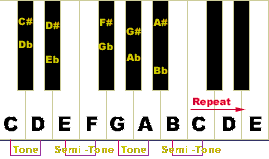
In order to understand how chords are formed, there are a few basic principles, you have to get to grips with.
Two notes constitute what is known as an interval. (Guitarists very often play two notes - especially when used with distortion - and call it a power chord, In reality it's an interval)
Three notes or more are necessary to create a legitimate chord.
Chords are based on scales.
Scales are a series of notes designed to make understanding the keyboard/fretboard more understandable.
In western music the chromatic scale contains all the notes
which can be played on a piano or guitar. Maybe your thinking - Wow! There
must be hundreds - No only twelve and they are named after the first seven
letters of the alphabet.
A - B - C - D - E - F - G So where are the other five.. ? They take
their names from the existing letters and just to make life difficult they
can have two names all depending on which key you are in, like this...
A# or Bb = (A sharp or B flat this is the same note)
Then - C# or Db - D# or Eb - F# or Gb - G# or Ab.
(Notice the # sign which tells you a note
is to be sharpened and the b sign which
tells you it must be flattened.) It is easier to see this concept. on a piano
keyboard, than it is on a guitar fret-board although the rule applies to both.
(See below.)

What are tones and semi-tones? They are ways of measuring the
distance between one note and another. Here are a few examples.... (Checking
these against the keyboard picture above should help you to visualise this idea.)
The distance between C and D equals one tone.
The distance between E and F equals one semi-tone.
The distance between F# and G# equals one tone.
The distance between A# and B equals one semi-tone.
The distance between F and F# equals one semi-tone
The distance between E and F# equals one tone
Whether the keys are white or black has no relevance, what is important is the distance to the next note. Put simply.. The distance between any note and the one directly beside it is a semi-tone. (Sometimes called a half step or half tone) The distance between any note and the one two steps above or below it is a tone. (Sometimes referred to as a whole tone.)
In this section I will be using this scale to demonstrate how to
form chords once you understand the basic principle of how this scale operates.
Once you have understood the principle of tones and semitones, you can
move on to the major scale.
The knack to the the scale is knowing this note pattern.
Tone - Tone - Semi-tone - Tone - Tone - Tone
Semi-tone.
No matter which note you start on, if you follow this pattern you can
find the major scale for each one.
Here is the C
Major scale on the keyboard. Due to the way the keyboard is designed.
it just so happens that if you start on a C
note and play all the white notes.. that will result in this scale.
Notice the tone semi-tone pattern of the notes..
|
C Major Scale |
|
|
Here is one possible position for a two octave C
major scale on a section of the guitar fret-board, starting at the seventh
fret.. Again notice the tone semitone pattern., it's more difficult to
see, but it's there..
Try starting on each open string and playing a major scale
on each one, to clarify to yourself, how the tone semitone routine works on the
guitar. When you can do it along one string, then try going across
the strings as in the example below. This pattern is movable.. What ever note
you start from.. That's the major scale that you are playing.
|
C Major Scale Guitar Pattern 7th Fret |
|
|
|
E Major Scale Positions Across The Guitar Fret-board. Break this scale down into sections as in the example above. After some time spent practising, it will become ingrained in your memory and you wont even have to think about it. |
|
|
If you can't be bothered with all this theory nonsense and just want to find chord shapes.. Download the Nut Chords 32 Chord Finder It's in zip format, so you will need a zip utility such as Winzip to uncompress it. If you don't have one get Power Archiver An explanation of this program and it's function can be found on my Downloads page.. If however, all this kind of stuff sets your pulses racing.... Are you in luck... Read on oh studious one... Chord Construction Part 2